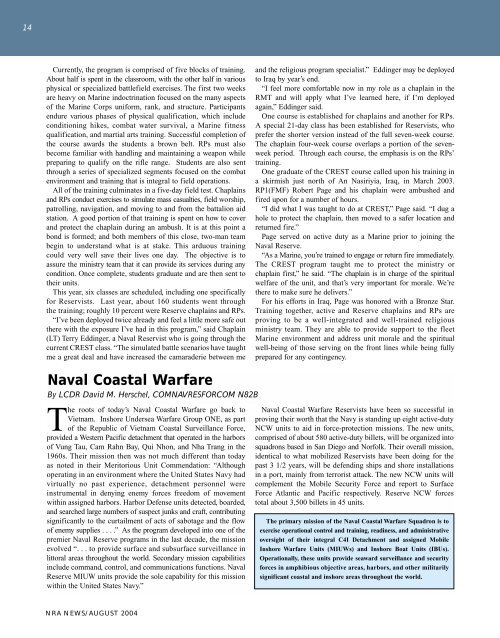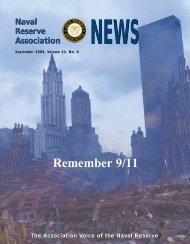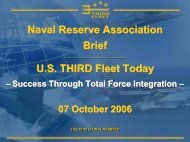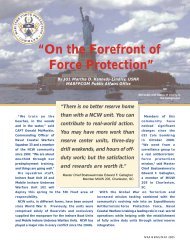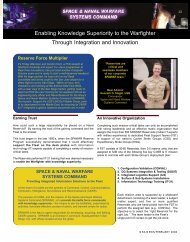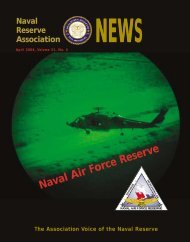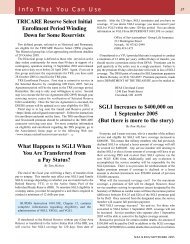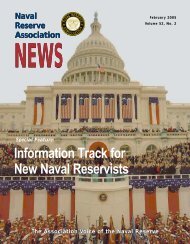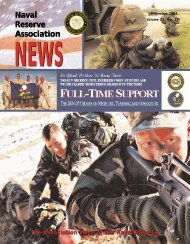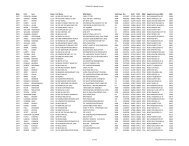Naval Reserve Association Naval Reserve Association
Naval Reserve Association Naval Reserve Association
Naval Reserve Association Naval Reserve Association
Create successful ePaper yourself
Turn your PDF publications into a flip-book with our unique Google optimized e-Paper software.
14<br />
Currently, the program is comprised of five blocks of training.<br />
About half is spent in the classroom, with the other half in various<br />
physical or specialized battlefield exercises. The first two weeks<br />
are heavy on Marine indoctrination focused on the many aspects<br />
of the Marine Corps uniform, rank, and structure. Participants<br />
endure various phases of physical qualification, which include<br />
conditioning hikes, combat water survival, a Marine fitness<br />
qualification, and martial arts training. Successful completion of<br />
the course awards the students a brown belt. RPs must also<br />
become familiar with handling and maintaining a weapon while<br />
preparing to qualify on the rifle range. Students are also sent<br />
through a series of specialized segments focused on the combat<br />
environment and training that is integral to field operations.<br />
All of the training culminates in a five-day field test. Chaplains<br />
and RPs conduct exercises to simulate mass casualties, field worship,<br />
patrolling, navigation, and moving to and from the battalion aid<br />
station. A good portion of that training is spent on how to cover<br />
and protect the chaplain during an ambush. It is at this point a<br />
bond is formed; and both members of this close, two-man team<br />
begin to understand what is at stake. This arduous training<br />
could very well save their lives one day. The objective is to<br />
assure the ministry team that it can provide its services during any<br />
condition. Once complete, students graduate and are then sent to<br />
their units.<br />
This year, six classes are scheduled, including one specifically<br />
for Reservists. Last year, about 160 students went through<br />
the training; roughly 10 percent were <strong>Reserve</strong> chaplains and RPs.<br />
“I’ve been deployed twice already and feel a little more safe out<br />
there with the exposure I’ve had in this program,” said Chaplain<br />
(LT) Terry Eddinger, a <strong>Naval</strong> Reservist who is going through the<br />
current CREST class. “The simulated battle scenarios have taught<br />
me a great deal and have increased the camaraderie between me<br />
and the religious program specialist.” Eddinger may be deployed<br />
to Iraq by year’s end.<br />
“I feel more comfortable now in my role as a chaplain in the<br />
RMT and will apply what I’ve learned here, if I’m deployed<br />
again,” Eddinger said.<br />
One course is established for chaplains and another for RPs.<br />
A special 21-day class has been established for Reservists, who<br />
prefer the shorter version instead of the full seven-week course.<br />
The chaplain four-week course overlaps a portion of the sevenweek<br />
period. Through each course, the emphasis is on the RPs’<br />
training.<br />
One graduate of the CREST course called upon his training in<br />
a skirmish just north of An Nasiriyia, Iraq, in March 2003.<br />
RP1(FMF) Robert Page and his chaplain were ambushed and<br />
fired upon for a number of hours.<br />
“I did what I was taught to do at CREST,” Page said. “I dug a<br />
hole to protect the chaplain, then moved to a safer location and<br />
returned fire.”<br />
Page served on active duty as a Marine prior to joining the<br />
<strong>Naval</strong> <strong>Reserve</strong>.<br />
“As a Marine, you’re trained to engage or return fire immediately.<br />
The CREST program taught me to protect the ministry or<br />
chaplain first,” he said. “The chaplain is in charge of the spiritual<br />
welfare of the unit, and that’s very important for morale. We’re<br />
there to make sure he delivers.”<br />
For his efforts in Iraq, Page was honored with a Bronze Star.<br />
Training together, active and <strong>Reserve</strong> chaplains and RPs are<br />
proving to be a well-integrated and well-trained religious<br />
ministry team. They are able to provide support to the fleet<br />
Marine environment and address unit morale and the spiritual<br />
well-being of those serving on the front lines while being fully<br />
prepared for any contingency.<br />
<strong>Naval</strong> Coastal Warfare<br />
By LCDR David M. Herschel, COMNAVRESFORCOM N82B<br />
The roots of today’s <strong>Naval</strong> Coastal Warfare go back to<br />
Vietnam. Inshore Undersea Warfare Group ONE, as part<br />
of the Republic of Vietnam Coastal Surveillance Force,<br />
provided a Western Pacific detachment that operated in the harbors<br />
of Vung Tau, Cam Rahn Bay, Qui Nhon, and Nha Trang in the<br />
1960s. Their mission then was not much different than today<br />
as noted in their Meritorious Unit Commendation: “Although<br />
operating in an environment where the United States Navy had<br />
virtually no past experience, detachment personnel were<br />
instrumental in denying enemy forces freedom of movement<br />
within assigned harbors. Harbor Defense units detected, boarded,<br />
and searched large numbers of suspect junks and craft, contributing<br />
significantly to the curtailment of acts of sabotage and the flow<br />
of enemy supplies . . . .” As the program developed into one of the<br />
premier <strong>Naval</strong> <strong>Reserve</strong> programs in the last decade, the mission<br />
evolved “. . . to provide surface and subsurface surveillance in<br />
littoral areas throughout the world. Secondary mission capabilities<br />
include command, control, and communications functions. <strong>Naval</strong><br />
<strong>Reserve</strong> MIUW units provide the sole capability for this mission<br />
within the United States Navy.”<br />
<strong>Naval</strong> Coastal Warfare Reservists have been so successful in<br />
proving their worth that the Navy is standing up eight active-duty<br />
NCW units to aid in force-protection missions. The new units,<br />
comprised of about 580 active-duty billets, will be organized into<br />
squadrons based in San Diego and Norfolk. Their overall mission,<br />
identical to what mobilized Reservists have been doing for the<br />
past 3 1/2 years, will be defending ships and shore installations<br />
in a port, mainly from terrorist attack. The new NCW units will<br />
complement the Mobile Security Force and report to Surface<br />
Force Atlantic and Pacific respectively. <strong>Reserve</strong> NCW forces<br />
total about 3,500 billets in 45 units.<br />
The primary mission of the <strong>Naval</strong> Coastal Warfare Squadron is to<br />
exercise operational control and training, readiness, and administrative<br />
oversight of their integral C4I Detachment and assigned Mobile<br />
Inshore Warfare Units (MIUWs) and Inshore Boat Units (IBUs).<br />
Operationally, these units provide seaward surveillance and security<br />
forces in amphibious objective areas, harbors, and other militarily<br />
significant coastal and inshore areas throughout the world.<br />
NRA NEWS/AUGUST 2004


